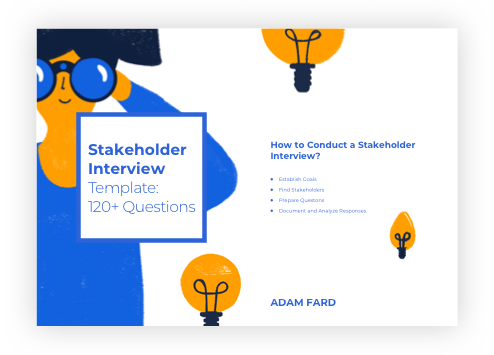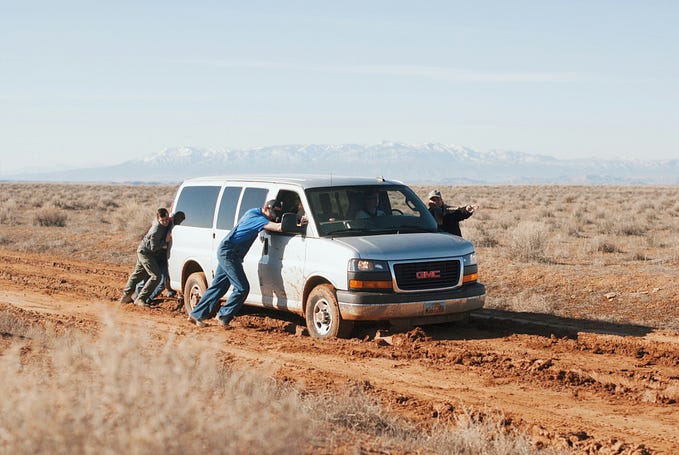The ultimate guide to stakeholder interviews: understand your clients

Stakeholder interviews are a big deal in UX design. They help establish the foundations for any project by providing valuable insights that would otherwise be difficult — even impossible — to obtain. These insights guide the flow of the entire project, such as business goals, technical constraints, usability problems, and more.
When properly planned and executed, stakeholder interviews are one of the most efficient research tools used in UX design.
Therefore, you need to take them seriously if you want to create a design that everyone will be happy with, both users and clients.
So, first things first …
What Are Stakeholder Interviews?

Stakeholder interviews are one-on-one conversations with people who have a vested interest in the success of the product you’re working on.
A stakeholder is anyone within an organization who can offer useful advice about the product and ultimately help simplify the design process. Additionally, stakeholders rely on the product’s success for their own gain, either personally or professionally. Although these are normally high-level employees, stakeholders can be lower-level employees or even prominent users.
But what if you’ve already discussed the project with the project manager and agreed about the scope of everything? Does this mean you should skip stakeholder interviews? Absolutely not.
You’ll be surprised at just how differently each stakeholder interacts with the product. Analyzing these perspectives will help you better understand what stakeholders want and need from the product.
Once you collect this information, you will be better equipped to deliver a great design that ticks all the boxes.
Why Are They Important for the Design Process?

Stakeholder interviews are valuable research tools used to kick-start the design process. They focus on extracting information from three main areas in UX design:
- User needs. How will the design help the users?
- Business goals. How will the design support business objectives?
- Technical limitations. What technical obstacles need to be overcome?
Stakeholder interviews are a great way to get the lay of the land. They help you understand user behavior, distinguish constraints, and identify pain points.
“A problem well stated is a problem half solved.”
— Charles Kettering
But that’s just the tip of the iceberg. There are several benefits of using stakeholder interviews in UX design, such as:
- Defining goals. Get a clearer idea about the scope and parameters of the project by speaking to multiple stakeholders. Gain context to help you set clear goals, establish milestones, and prioritize tasks.
- Improving communication. Sitting down with stakeholders is the perfect opportunity to really get to know the people working behind the scenes. Collaboration and good rapport with stakeholders will also give you a better sense of appreciation and validate your design efforts.
- Sharing a cohesive vision. Speak with more than one stakeholder to shed light on multiple perspectives. Doing so will ensure that you’re on the same page with everyone from the start and stop you from second-guessing your design decisions later on.
- Earning trust and buy-in. Showing stakeholders that their opinion matters will not only give you good data to work with, but it will also earn you their trust and buy-in. You’ll find that it’s always easier working with clients who feel that their voice is being heard during the design process.
There’s much to learn from stakeholders. You just have to be willing to listen and take notes.
How to Conduct a Stakeholder Interview

Failure to plan and execute a stakeholder interview correctly can come back to haunt you. Here’s how you should plan and conduct a successful stakeholder interview.
Establish Goals

Start your UX research by setting goals for the stakeholder interview, namely, what you want to find out from interviewees. Here are key bits of information that you’ll want to know by the end of the conversation:
- What are the short- and long-term business goals?
- What is the stakeholder’s role in the company?
- Who are the users?
- What are a few major competitors?
- Are there any technological limitations?
- What are a few product concerns?
- What is the stakeholder’s definition of product success?
“There is nothing so terrible as activity without insight.”
— Johann Wolfgang von Goethe
Establishing goals will help you stay on track during the stakeholder interviews.
Find Stakeholders

The very essence of stakeholder interviews is to locate key figures and extract as much useful information from them as you can. In smaller companies, speaking with a founder or executive will suffice. In larger companies, however, you can expect more people to interact with the product, so you will need to interview more stakeholders.
Choose up to 5 stakeholders who represent different sectors of the company so you have a broader spectrum of insights.
A good rule of thumb is to speak to the people who spend the most time using the product. By speaking to the right people and asking the right questions, you can easily collect information about goals, problems, expectations, and other data that will determine exactly what the design process should encompass. Choose wisely.
Prepare Questions

To successfully conduct a stakeholder interview, you need to know whom to talk to and what to ask. As simple as that may seem, this is the part where many researchers come up short.
In most situations, the best types of questions are open-ended because these require interviewees to go into more detail, thus providing greater insight. Closed-ended questions, in contrast, can only elicit a yes/no response, which won’t be very useful in your research.
Remember, the interview should be steered in a more conversational direction. Although preparing specific questions is important, avoid asking them in a way that makes it seem like you’re just checking off bullet points on a list.
It’s perfectly fine to go off-script and let the interview ebb and flow naturally, depending on the person being interviewed. Do not hesitate to ask clarifying questions, even for answers that appear obvious.
If you really want to get the most out of your stakeholders, try the following interview style:
- Pretend you know absolutely nothing.
- Leave your power suit at the door.
- Listen carefully and don’t interrupt.
- Close silence gaps by rewording questions.
- Insist on getting into details.
Document and Analyze Responses

Take notes — or have someone to take notes — during the interviews. Like with all research, the data you collect mean nothing until you analyze them to draw your findings.
Start by analyzing individual interviews, and then move on to examining them collectively. Write up a report to summarize everything. Try organizing your research findings into categories:
- Business
- Users
- Problems
- Fears
- Motives
- Competitive advantages
- Solutions
- Alternatives
- Unique value propositions
Your findings will then help you define UX milestones and objectives.
One useful tip is to record your interview session. Doing so lets you stay focused on the flow of the interview without having to worry about whether you capture every answer word for word. Recording the interview also means you can take notes afterward and reflect on the responses accordingly.
Whether you’re working with a large corporation, an up-and-coming startup, or a small family-owned business, stakeholder interviews are key to establishing a meaningful connection with clients and making sure everyone is on the same page throughout the UX design process.
Start planning your stakeholder interview to ensure that you create a design that is easy to use, practical, and satisfies business objectives.
To Watch: UX Design Process
Further Readings
In need of UX / Behavioral Designer? Visit adamfard.com and drop me a line!
Originally published at adamfard.com | The Ultimate Guide to Stakeholder Interviews: Understand Your Clients








